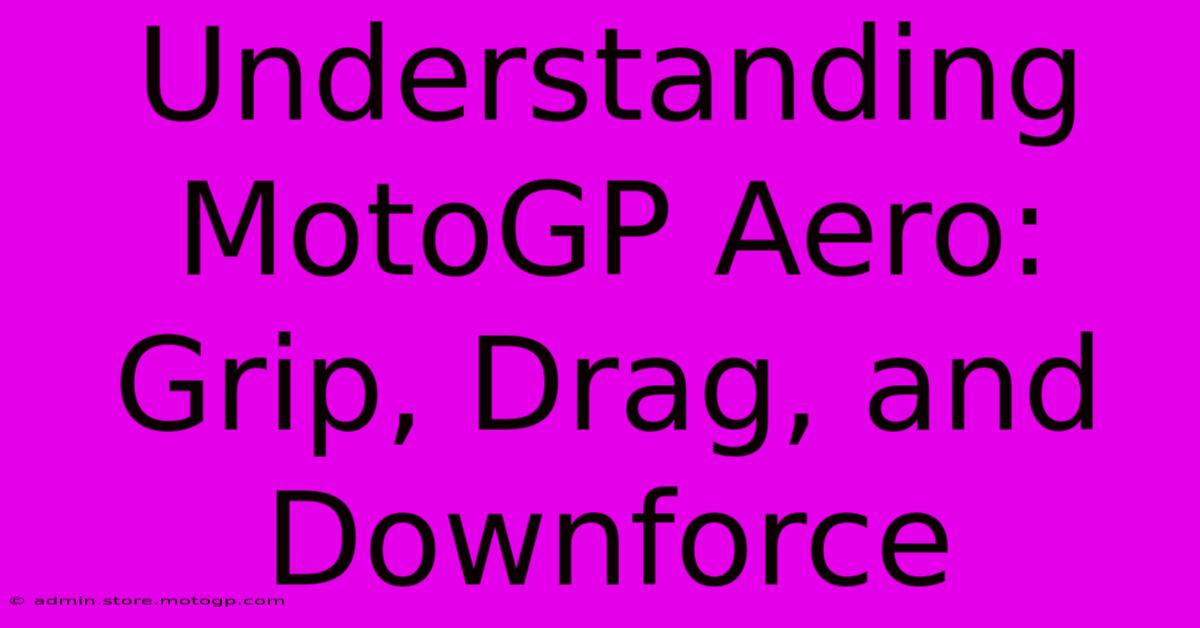Understanding MotoGP Aero: Grip, Drag, And Downforce

Table of Contents
Understanding MotoGP Aero: Grip, Drag, and Downforce
MotoGP, the pinnacle of motorcycle racing, is a relentless pursuit of speed and precision. While rider skill is paramount, the sophisticated aerodynamics of the machines play a crucial, often unseen, role in determining race outcomes. Understanding the interplay of grip, drag, and downforce is key to appreciating the technological marvel that is a modern MotoGP bike.
The Trifecta of MotoGP Aerodynamics: Grip, Drag, and Downforce
The aerodynamic package on a MotoGP bike is a complex interplay of three key forces:
-
Drag: This is the resistance a bike experiences as it moves through the air. Reducing drag is vital for achieving higher top speeds on straights. Think of it as the air pushing against the bike. Every gram of drag counts at these speeds.
-
Downforce: This is the force that pushes the bike down towards the track surface. It's generated by carefully designed aerodynamic components, increasing grip and allowing for faster cornering speeds. More downforce equals higher cornering speeds, but it also increases drag.
-
Grip: While not strictly an aerodynamic force, grip is directly influenced by aerodynamics. Downforce increases the contact pressure between the tires and the track, leading to improved grip and allowing for more aggressive riding styles. More grip translates to faster lap times and better stability.
How MotoGP Bikes Generate Downforce
Unlike cars, MotoGP bikes don't rely on large wings or spoilers for downforce. Instead, they employ a variety of cleverly designed components:
-
Fairings: The bodywork itself is sculpted to direct airflow effectively. The shape and surface texture are meticulously engineered to create low pressure areas beneath the bike, generating downforce.
-
Wings: While less prominent than in other motorsport categories, winglets and small wings are strategically placed to manage airflow and generate downforce. These are often located on the front fairing and sometimes on the swingarm.
-
Underbody Aerodynamics: A significant portion of downforce is generated from the underbody. This area is often quite complex, featuring carefully designed tunnels and channels to manipulate airflow and maximize downforce.
The Constant Balancing Act
The challenge for MotoGP engineers isn't simply maximizing downforce. It's about finding the optimal balance between downforce, drag, and stability. More downforce helps cornering, but it increases drag, reducing top speed. Therefore, teams constantly tweak their aerodynamic setups based on the specific track characteristics. A track with many long straights will require a setup prioritizing lower drag, while a track with many tight corners benefits from increased downforce.
The Evolution of MotoGP Aerodynamics
MotoGP aerodynamics have undergone a dramatic evolution over the years. The introduction of winglets sparked intense debate and subsequent regulations, highlighting the constant push for performance gains. Teams are continually experimenting with new designs and materials to refine their aerodynamic packages, pushing the boundaries of what's possible.
Conclusion: The Unsung Heroes of Speed
The sophisticated aerodynamics of a MotoGP bike are a testament to the dedication and ingenuity of engineers. While often unseen, the intricate interplay of grip, drag, and downforce is fundamental to the incredible speeds and breathtaking cornering capabilities we witness in MotoGP races. The next time you watch a race, take a moment to appreciate the aerodynamic masterpiece beneath the rider. It's not just about horsepower; it's about the science of speed.

Thank you for visiting our website wich cover about Understanding MotoGP Aero: Grip, Drag, And Downforce. We hope the information provided has been useful to you. Feel free to contact us if you have any questions or need further assistance. See you next time and dont miss to bookmark.
Featured Posts
-
Gp Results Your Guide To Healthy Living
Feb 20, 2025
-
Moto Gp Photoshoot The Story Behind The Image
Feb 20, 2025
-
Moto Gp Bike For Sale The Perfect Track Companion
Feb 20, 2025
-
From Zero To Hero The Journey Of Motorcycle Grand Prix Winners
Feb 20, 2025
-
Moto Gp Photoshoot The Ultimate Fan Experience
Feb 20, 2025
